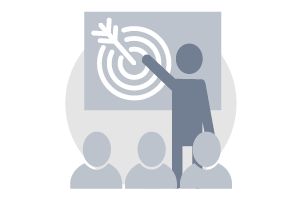The fishbowl conversation method allows a large group of workshop participants to observe, participate in, and learn from a discussion. The conversation is managed in a controlled format.
OVERVIEW
The method involves a smaller group of participants debating or discussing an issue, while the rest of the group listens to their exchange. The observers are also allowed to participate in the discussion, by swapping out with one of the debaters. The discussion and the rotation of debaters can be moderated by the facilitator, depending on the format used. (See: Open Fishbowl and Closed Fishbowl, in ‘Implementation Steps’ section)
WORKSHOP PHASE
NUMBER OF PARTICIPANTS
At least 15 participants
TIME |
MODE OF DELIVERY
At least 30 minutes | F2F & Online
TOOLS/MATERIALS
- Five or six chairs for the debaters. Online version: A videoconferencing platform that will allow speakers to turn on their microphone and cameras.
- If required: More chairs for the rest of the participants.
- A large enough area to allow for the concentric circles of chairs, or for observers to form a standing circle around in inner circle of chairs.
PREPARATION
- The five or six debaters’ chairs are placed in a large area, and arranged in a circle
- Around this circle, more chairs are arranged (facing inward) in a circular fashion, for the rest of the participants. (Alternatively, and especially for smaller groups, the participants can stand around the smaller, inner circle of chairs).
- The facilitator should decide on the problem or situation that will be discussed. The topic should be suitable for a debate, i.e. with no obvious solution, allowing for different viewpoints – each with possible pros and cons.
- If the facilitator will also act as a debate moderator, they can prepare a few guiding questions or prompts to keep the discussion active.

Step 1
The facilitator explains the objective and structure of the fishbowl exercise. One of two format can be followed
- Open Fishbowl: In this format, a chair in the debaters’ circle is left empty. Any of the observers may, at any time, approach the inner circle and take a seat in the empty chair. When this happens, a current debater should voluntarily leave the circle. The discussion will continue as the swap occurs. Online version: One of the observers can raise their hand, virtually, if they want to join the discussion. The moderator then pauses the virtual debate, so that the volunteer can join the discussion whilst another debater turns off their mic and camera and ‘leaves’ the debate to become an observer.
- Closed Fishbowl: All chairs are filled in this format, and the discussion is timed. Once the allocated time for that discussion has run out, all members of the inner circle are replaced by an entirely new group. The debate continues until all participants have engaged in the discussion.

Step 2
The facilitator selects four or five participants as the first round of debaters. These debaters take their seats in the centre circle. Online version: The debaters switch on their microphone and cameras.

Step 3
The rest of the participants either sit or stand around the centre circle of debaters. Online version: The observing participants switch off their microphone and cameras. If required: The facilitator explains that they will act as moderator. They will ensure the debate remains on topic, and introduce leading questions where necessary.

Step 4
The facilitator presents the topic, and opens the debate.

Step 5
Participants acting as observers do not participate in the debate, but rather evaluate the arguments. They make notes on what they learn from listening to the different perspectives.

Step 6
The fishbowl is concluded with a group discussion, where the observers share a summary, their general impressions or critical comments on the debate. The debaters can also comment on their experience – i.e. on what new insights they may have gained by engaging in a critical, structured dialogue with others.
The first round of debaters can be informed, prior to the workshop, that they will be asked to open the fishbowl exercise, and be alerted to the topic of discussion. By allowing them some time to think about the topic, an active debate can immediately start, and the debaters will be able to better articulate their views. This will set the tone for the rest of the discussion.
The above guidelines were developed by the database contributors and draws on their own practical experience of workshop facilitation, as well as the following resources:
- Teaching Strategies: Fishbowl (2022). Facing History & Ourselves. Retrieved on 10 August 2022 from https://www.facinghistory.org/resource-library/teaching-strategies/fishbowl
The fishbowl can also be structured as a two-way conversation, focused on two clearly opposing views on a topic. In this format, only two chairs are used in the centre. An observer can join the debate by tapping the shoulder of the debater they want to replace when that person is not speaking. That debater then leaves the chair, allowing a new person (with a similar viewpoint) to take their seat. The discussion carries on from there.
« Methods

